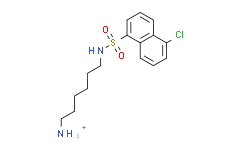| Cas No.: | 61714-27-0 |
| Chemical Name: | W-7 HYDROCHLORIDE |
| Synonyms: | W-7 HYDROCHLORIDE;N-(6-Aminohexyl)-5-Chloronaphthalene-1-Sulphonamide Hydrochloride;N-(6-Aminohexyl)-5-chloro-1-naphthalenesulfonamide Hydrochloride;N-(6-aminohexyl)-5-chloronaphthalene-1-sulfonamide,hydrochloride;W-7 (hydrochloride);N-(6-aminohexyl)-1-naphthalene sulfonamide hydrochloride;N-(6-Aminohexyl)-5-chloro-1-naphthalenesulfonamide monohydrochloride;N-(6-Aminohexyl)-5-chloro-1-naphthalenesulfonamide,HCl;W-7;W-7 Hydrochloride |
| SMILES: | [NH3+]CCCCCCNS(C1=CC=CC2C(=CC=CC1=2)Cl)(=O)=O |
| Formula: | C16H22ClN2O2S |
| M.Wt: | 341.876081943512 |
| Purity: | >98% |
| Sotrage: | 2 years -20°C Powder, 2 weeks 4°C in DMSO, 6 months -80°C in DMSO |
| Description: | W-7 hydrochloride is a selective calmodulin antagonist. W-7 hydrochloride inhibits the Ca2+-calmodulin-dependent phosphodiesterase and myosin light chain kinase with IC50 values of 28 μM and 51 µM, respectively[1][2]. W-7 hydrochloride induces apoptosis and has antitumor activity[3]. |
| Target: | IC50: 28 μM (Phosphodiesterase) and 51 µM (Myosin light chain kinase)[1] |
| In Vivo: | W-7 (3 mg/kg; intraperitoneal injection; on 5 consecutive days per week; female BALB/c nu mice) treatment significantly reduces tumor growth in a murine MM model[3]. Animal Model: Female BALB/c nu mice (6-week-old) injected with RPMI 8226 cells[3] Dosage: 3 mg/kg Administration: Intraperitoneal injection; on 5 consecutive days per week Result: Significantly reduced tumor growth in a murine MM model. |
| In Vitro: | W-7 is distributed mainly in the cytoplasm, and inhibits proliferation of Chinese hamster ovary K1 (CHO-K1) cells. W-7 selectively blocks the phase of the cell cycle (G1/S boundary phase) in a manner. 25 μM W-7 arrests the growth of the cells at the G1/S boundary phase of the cell cycle[1]. W-7 (100 μM) exhibits a similar extent of antagonism between the contractile responses to carbachol and KCl. The increase in myosin light chain (P-LC) phosphate content in response to 1-min stimulation with 10 μM carbachol is inhibited by W-7. W-7 antagonizes the smooth muscle contraction through the inhibition of the initial increase in the P-LC phosphorylation[2]. Treatment with W-7 results in the dose-dependent inhibition of cell proliferation in various human multiple myeloma cell lines. W-7 induces G1 phase cell cycle arrest by downregulating cyclins and upregulating p21cip1. W-7 induces apoptosis via caspase activation; this occurred partly through the elevation of intracellular calcium levels and mitochondrial membrane potential depolarization and through inhibition of the STAT3 phosphorylation and subsequent downregulation of Mcl-1 protein[3]. W-7 competitively inhibits Ca2+/calmodulin-dependent phosphodiesterase with a Ki value of 300 μM[4]. |
| References: | [1]. H Hidaka, et al. N-(6-aminohexyl)-5-chloro-1-naphthalenesulfonamide, a Calmodulin Antagonist, Inhibits Cell Proliferation. Proc Natl Acad Sci U S A. 1981 Jul;78(7):4354-7. [2]. M Asano. Divergent Pharmacological Effects of Three Calmodulin Antagonists, N-(6-aminohexyl)-5-chloro-1-naphthalenesulfonamide (W-7), Chlorpromazine and Calmidazolium, on Isometric Tension Development and Myosin Light Chain Phosphorylation in Intact Bovine Tracheal Smooth Muscle. J Pharmacol Exp Ther. 1989 Nov;251(2):764-73. [3]. H Itoh, et al. Direct Interaction of Calmodulin Antagonists With Ca2+/calmodulin-dependent Cyclic Nucleotide Phosphodiesterase. J Biochem. 1984 Dec;96(6):1721-6. [4]. Shigeyuki Yokokura, et al. Calmodulin Antagonists Induce Cell Cycle Arrest and Apoptosis in Vitro and Inhibit Tumor Growth in Vivo in Human Multiple Myeloma. BMC Cancer. 2014 Nov 26;14:882. |

 To enhance service speed and avoid tariff delays, we've opened a US warehouse. All US orders ship directly from our US facility.
To enhance service speed and avoid tariff delays, we've opened a US warehouse. All US orders ship directly from our US facility.




















